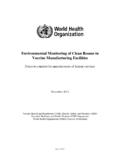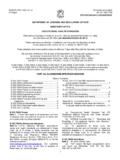Transcription of Cyber Security for Industrial Automation and Control ...
1 1 Cyber Security for Industrial Automation and Control Systems (IACS) Open Government status Open Target audience Chemical Explosives and Microbiological Hazards Division (CEMHD) and Energy Division, Electrical Control and Instrumentation (EC&I) Specialist Inspectors Contents Cyber Security for Industrial Automation and Control Systems (IACS) .. 1 Open Government status .. 1 Target audience .. 1 Summary .. 2 Introduction .. 2 Action .. 4 Background .. 4 Organisation .. 4 Targeting .. 4 Timing .. 4 Resources .. 4 Recording & Reporting .. 4 Health & Safety .. 4 Diversity .. 4 Further References .. 5 Relevant Regulations .. 5 Recognised Good Practice .. 5 Other Relevant Standards .. 5 Contacts .. 5 Appendix 1: Process for the Management of Cyber Security on IACS .. 6 Note 1 Security Threat .. 7 Note 2 Cyber Security Management System (CSMS).
2 7 Note 3 Defining the IACS .. 10 Note 4 Risk assessment .. 12 Note 5 Define and Implement Countermeasures .. 13 Note 6 Safety Instrumented Systems (SIS) .. 15 2 Appendix 2: Example Simple Network Drawings .. 18 Appendix 3: Risk assessment .. 23 Appendix 4: Security Countermeasures .. 25 Appendix 5: Additional SIS Considerations .. 37 Summary This Operational Guidance represents the Health and Safety Executive (HSE) interpretation of current standards on Industrial communication network and system Security , and functional safety in so far as they relate to major hazards workplaces. This guidance does not cover protection of critical infrastructure ( utility networks) or protection of information on corporate networks. For the purpose of the enforcement management model, this guidance is an interpretive standard. This Operational Guidance could contribute towards a suitable demonstration of compliance with relevant H&S legislation, in order to demonstrate Cyber Security risks have been managed to as low as reasonably practicable (ALARP).
3 Alternative equivalent means may also be used to demonstrate compliance. Introduction Cyber Security is a term used to define measures taken to protect Industrial Automation and Control Systems (IACS) against threats to Security through accidental circumstances, actions or events, or through deliberate attack. The threats can originate from the internet, corporate networks, maintenance activities, software upgrades, and unauthorised access etc. with the potential to result in incidents with major health, safety or environmental consequences. Duty holders may operate a range of systems for Control and safety functions which can be vulnerable to threats. These typically include: Control systems which comprise: Distributed Control Systems (DCS), Programmable Logic Solvers (PLC), Supervisory Control and Data Acquisition systems (SCADA) and/or other programmable systems.
4 Safety Instrumented Systems (SIS), which may range from simple logic systems to complex programmable safety PLC type systems. Plant Information systems such as data historian, programming interfaces, and data servers. Network infrastructure to provide connectivity to the above. Connectivity to systems outside the IACS (often known as the corporate LAN etc.) Virtual machine environments Programmable switchgear, drives, sensors & actuators 3 IACS are now more accessible and open than ever before with increasing use of commercial-off-the-shelf (COTS) information technology (IT) solutions, allowing connectivity and exchange of data with other systems and within corporate networks. IACS are thus increasingly merging with corporate systems. This, together with an increased use of non-proprietary systems ( Windows, typically for operator interface and engineering workstations), has led to modern IACS becoming potentially more vulnerable to a Cyber -attack.
5 Prevention and mitigation of accidents is the responsibility of the duty holder, typically the owner or operator of the IACS. This is normally achieved through the application of good practice, an assessment of the hazards and risks posed and application of appropriate risk reduction measures. However, normal risk assessment processes such as hazard and operability studies (HAZOP), process hazard risk analysis (PHR) etc. are not sufficient to address Security threats to IACS since they do not, in general, consider multiple contingencies ( several things occurring at once) or those that have malicious intent. Therefore, it is not possible to discount Security threats on the basis of traditional process and hazard studies or to assume that the risk of such threats will be addressed by existing risk reduction measures alone. Duty holders may use IT and business Cyber Security solutions ( firewalls, anti-virus software etc.)
6 To improve Security of the IACS, but these need to be applied in the correct way as part of a holistic approach incorporating people, process and technology. It may not be possible for legacy IACS systems (which were designed prior to widespread Cyber Security threats) to comply with all the requirements of the quoted standards. It is expected however that duty holders should take reasonably practicable steps to reduce Security risks . The following guiding principles were used in producing this guidance: Protect, detect and respond. It is important to be able to detect possible attacks and respond in an appropriate and timely manner in order to minimise the impacts. Defence in depth. No single Security countermeasure provides absolute protection as new threats and vulnerabilities can be identified at any time. To reduce these risks , implementing multiple protection measures in series avoids single point failures.
7 Technical, procedural and managerial protection measures. Technology is insufficient on its own to provide robust levels of protection. This topic is rapidly developing and therefore this guidance may be updated in future as new developments occur. 4 Action Inspectors should: Use the high level process described in Figure 1 and the accompanying notes in the associated Appendices to verify, or otherwise: o the adequacy of a Cyber Security management system; o the adequacy of Security countermeasures and architecture practices. Refer duty holders to the high level process described in Figure 1 and the accompanying notes in the associated Appendices. Background Whilst it is expected that standards for IACS Security will continue to be developed, this document provides guidance to CA / HSE inspectors with a practical interpretation of the standards.
8 It also takes a proportionate approach for major hazard workplaces regulated by the CA / HSE where Security threats could pose a risk. Duty holders may need to work with IACS manufacturers / vendors and system integrators etc. to achieve the requirements. International Standards are being developed, for example the ISA/IEC62443 series of Standards Security for IACS . These provide a process for analysing risk and also provide further information for the design, installation, inspection, maintenance and testing of Cyber Security countermeasures but are currently in draft format. Organisation Targeting CA / HSE regulated major hazard workplaces where Cyber - Security could pose a major accident risk to the health and / or safety of employees and / or members of the public and / or environment. This guidance will be applicable to duty holders who own / operate IACS and to IACS manufacturers and system integrators.
9 Timing Ongoing. Resources To be used by EC&I Specialist Inspectors during interventions at major hazard workplaces. Recording & Reporting No special requirements. Health & Safety No special requirements. Diversity No special requirements. 5 Further References Relevant Regulations Control of Major Accident Hazards Regulations (COMAH) 2015 The Offshore Installations (Offshore Safety Directive) (Safety Case etc.) Regulations 2015 Offshore Installations (Prevention of Fire and Explosion, and Emergency Response) Regulations 1995 Specified Animals Pathogens Order (SAPO) Pipelines Safety Regulations 1996 Gas Safety (Management) Regulations 1996 Recognised Good Practice BS EN 61511 (Edition 2) Functional safety Safety instrumented systems for the process industry sector Other Relevant Standards Security Countermeasures Related to Safety Instrumented Systems (SIS).
10 BS EN / IEC 62443; 4 Parts. At time of writing some of the parts were in development Part 1 - Framework and threat-risk analysis (including IEC/TS 62443-1-1, IEC/TR 62443-1-2, IEC 62443-1-3, IEC/TR 62443-1-4). Part 2 - Security assurance: principles, policy and practice (including BS IEC 62443-2-1:2010, IEC/TR 62443-2-2, PD IEC/TR 62443-2-3:2015, IEC 62443-2-4). Part 3 - Sets of Security requirements for typical Security scenarios (including IEC/TR 62443-3-1, IEC 62443-3-2, IEC 62443-3-3:2013). Part 4 Product and technical Security requirements (including IEC 62443-4-1, IEC 62443-4-2) Note that part 4 is more relevant to manufacturers and system integrators etc. rather than duty holders. Other Relevant Guidance These provide useful background and further information on Cyber Security : 10 Steps to Cyber Security National Cyber Security Centre Security for Industrial Control Systems NIST Publication 800-82 Guide to Industrial Control Systems (ICS) Security EEMUA Doc: 8822 Cyber Security assessment process for Industrial Control systems Contacts Chemicals, Explosives and Microbiological Hazards Division; Electrical, Control and Instrumentation team.












